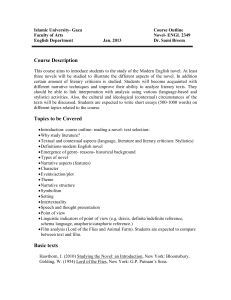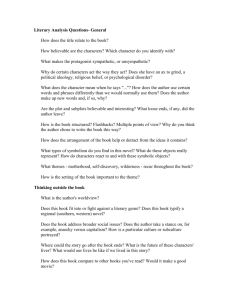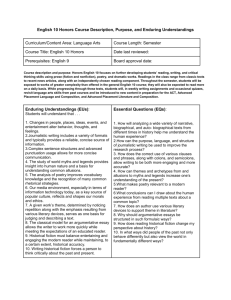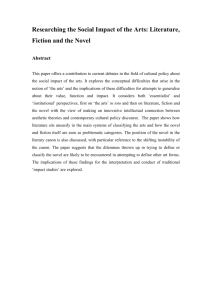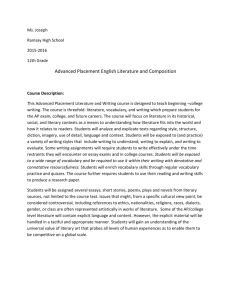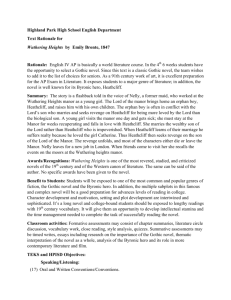Teacher Name: Mr. Westfall and Mrs. Antonyzyn Grade Level: 7th
advertisement
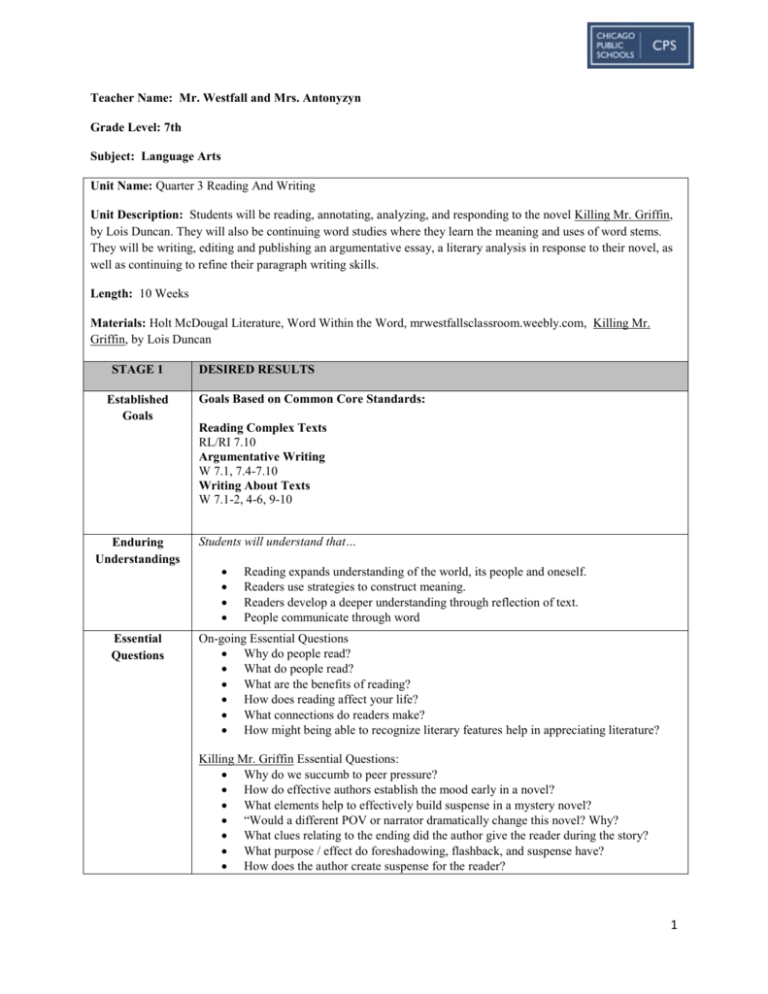
Teacher Name: Mr. Westfall and Mrs. Antonyzyn Grade Level: 7th Subject: Language Arts Unit Name: Quarter 3 Reading And Writing Unit Description: Students will be reading, annotating, analyzing, and responding to the novel Killing Mr. Griffin, by Lois Duncan. They will also be continuing word studies where they learn the meaning and uses of word stems. They will be writing, editing and publishing an argumentative essay, a literary analysis in response to their novel, as well as continuing to refine their paragraph writing skills. Length: 10 Weeks Materials: Holt McDougal Literature, Word Within the Word, mrwestfallsclassroom.weebly.com, Killing Mr. Griffin, by Lois Duncan STAGE 1 Established Goals DESIRED RESULTS Goals Based on Common Core Standards: Reading Complex Texts RL/RI 7.10 Argumentative Writing W 7.1, 7.4-7.10 Writing About Texts W 7.1-2, 4-6, 9-10 Enduring Understandings Essential Questions Students will understand that… Reading expands understanding of the world, its people and oneself. Readers use strategies to construct meaning. Readers develop a deeper understanding through reflection of text. People communicate through word On-going Essential Questions Why do people read? What do people read? What are the benefits of reading? How does reading affect your life? What connections do readers make? How might being able to recognize literary features help in appreciating literature? Killing Mr. Griffin Essential Questions: Why do we succumb to peer pressure? How do effective authors establish the mood early in a novel? What elements help to effectively build suspense in a mystery novel? “Would a different POV or narrator dramatically change this novel? Why? What clues relating to the ending did the author give the reader during the story? What purpose / effect do foreshadowing, flashback, and suspense have? How does the author create suspense for the reader? 1 Students will know… The difference between argument and persuasion Claims, evidence, and counterclaims The theme or central idea of a text Topic, central idea, supporting details Literal and inferential meaning Summarizing Drawing conclusions from textual and/or visual evidence Making connections across a variety of text (short, extended, online, etc.)Applying the qualities of informative/explanatory writing Elements of identity include language, clothing,, environment, values, etc. Identity is shaped by internal and external components. Details in a text work together to convey an overall meaning. Purpose and function of informative/explanatory texts. Figurative language Academic Vocabulary: Students will be able to… Analogies Context Clues Restatement Definition Denotation Connotation Comparison/contrast General Sentence Paragraph Idioms Metaphor Simile Antagonist Autobiography Historical Fiction Nonfiction External conflict Fable Falling action Fantasy Fiction Folktale • • • • • • • • • • • • • Objective point of view Omniscient point of view Plot Plot line Point of view Prose Protagonist Realistic fiction Recurring themes Resolution Rising action Science fiction Setting Students will be able to… Determine the topic, central idea, and supporting details of a nonfiction text Cite several pieces of textual evidence to support their analysis of a text Read and respond to shorter informational texts on the same topic Determine a theme or central idea of a text fictional text Determine the meaning of words or phrases as they are used in a text, both figuratively and connotatively Determine the denotation and connotation of words Analyze how a novels form and structure contribute to its meaning, specifically the fictional genre of mystery and several non-fiction text structures Analyze how an author develops and contrasts the points of view of different characters in a text Write arguments to support claims with clear reasons and relevant evidence 2 STAGE 2 Performance Tasks Other Evidence Produce clear and coherent writing Use technology, including the internet, to produce, edit, revise and publish writing ASSESSMENT EVIDENCE Writing Workshop: Argumentative Students write clear, coherent, and focused essays to gain adequate mastery of a range of skills and applications. Organization and cohesion Evidence (with a focus on arguments based on the ideas and facts gathered through the reading of short and extended texts) Support all statements and claims with anecdotes, descriptions, facts and statistics, and specific examples. Edit and revise writing to improve organization and word choice after checking the logic of the ideas and the precision of the vocabulary Evaluated by rubric Literary Analysis: Identify three literary elements in Killing Mr. Griffin that create suspense and analyze Lois Duncan’s development of those literary elements Cite textual evidence as part of an analysis of these elements Evaluated by rubric Daily and weekly on-going checks for understanding: Board work, quizzes, tests, discussions, paragraph writing, annotations, conferencing and small group work Self-Assessment: Students will regularly be asked to self-assess to improve the learning process. This may be in the form of a checklist, conferencing and journal or reflection writing. Reading Grade Breakdown: 35% Class Participation (ex. warm-ups, board work, annotations, DEAR time, participation in class discussions, small group work) 55% Assessments (ex. tests, quizzes, novel-based projects, class presentations) 10% Homework (ex., nightly assignments, long term assignment check-ins, News ELA articles, reading log) Writing Grade Breakdown: 35% Class Participation (ex. warm-ups, peer editing, board work, 1st and 2nd drafts of essay assignments, Word within the word quizzes) 55% Assessments (ex. tests, class discussions, essay assessments-final draft, class presentations) 10% Homework (ex., word within the word assignments, editing essay assignments, nightly writing assignments) STAGE 3 Learning Activities HOME CONNECTION Regularly check parent portal Make sure your child is reading daily (recorded on reading log) Discuss what your child is reading with him/her Take your child on trips such as museums Provide your child access to non-fiction materials such as newspapers, and magazines Have your child watch documentaries 3 Bring your child to the local library to check out books Enforce time-management skills by reviewing long term and short term projects and goal setting 4
